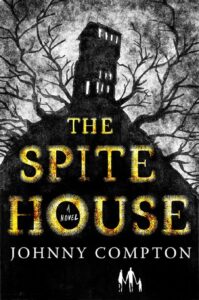“The air was filled with phantoms, wandering hither and thither in restless haste, and moaning as they went. Every one of them wore chains…none were free.” – Charles Dickens, A Christmas Carol
Supernatural fiction and ghostlore isn’t exactly short on miserable and pitiable spirits. A few of the more famous examples include, La Llorona, the infanticidal “weeping woman” of Latin American legend, Jacob Marley, the sorrowful, chain-bound harbinger of A Christmas Carol, and the unfortunate, murdered mother-son tandem Kayako and Toshio from Ju-On: The Grudge.
These and more are trapped in a hellish afterlife that is presumably endless. For Marley and La Llorona—in the traditional versions of her tale—their torment is self-made, arguably deserved, particularly for the known murderer, although if we figure Marley to be at least as callous as Scrooge we could presume he was indirectly accountable for a death or two, just as Scrooge felt he was for of Tiny Tim’s death. Even keeping in mind their villainy, it’s not too difficult to have some sympathy for their ordeal.
As Marley describes it, they suffer a fate worse than death. “No rest, no peace. Incessant torture of remorse.”
Marley said this specifically of a host of anguished souls that Scrooge sees through his window, all encumbered by chains and other metal fixtures. Charles Dickens was not the originator of rattling, phantom chains, of course. This unwelcome accessory is commonly believed to have originated with a ghost story from classical history, which doubles as early evidence of how a fear of ghosts can just make things worse for the haunter.
As told by Pliny the Younger, there was a house in Athens haunted by the “extremely emaciated and squalid” spirit of an old man. Most who saw the ghost fled the house, leaving it abandoned. The only one brave enough to follow the ghost when it beckons is the philosopher Athenodorus. The slow-moving spirit leads him to an unmarked grave on the property.
“…the skeleton of a man in chains was found there; for the body, having lain a considerable time in the ground, was putrefied and moldered away from the fetters. The bones being collected together were publicly buried, and thus after the ghost was appeased by the proper ceremonies, the house was haunted no more.”
For those who ran from the spirit, their terror was fleeting and escapable. Their reaction is understandable on one hand, and almost indefensible on the other. What did they see really? A starved, bound, frail old man calling out to them. That they never thought of trying to help him would be inexcusably callous if not for the fact that he was dead. Although from the ghost’s perspective, how much difference between death and life would there be, aside from perhaps now being unable to rest or even wish for death anymore?
Before Athenodorus interceded, the ghost’s story was that of a being that generated “the most dreadful terrors imaginable,” as opposed to that of an old slave or prisoner apparently slain and buried with little care or ceremony in the chains he must have loathed in life. Even with his story properly told, his chains have far outlived even his afterlife. Although they’re rarely found adorning ghosts in most stories and legends, chains are still so strongly associated with ghosts—at least in the West—that Lisa Morton fittingly titled a chapter of her excellent book Ghosts: A Haunted History, “Rattling Chains and White Sheets.” Funeral cerements and iron bindings. A dreadful dress code. What could inspire more sympathy?
Well, what’s red and wet and ghastly to drink but needs to be inside you?
The titular Anna of Anna Dressed in Blood is wearing a blood-stained dress, so the title isn’t quite literal, but still quite menacing. Except, the blood on her dress is her own, and everyone knows this. She is a murder victim, cursed to remain in the house where she died and even in the clothes she died in, and the locals know of her backstory, but they still see her as something to be feared more than mourned.
Sure, she has allegedly killed everyone who has set foot in the house that she haunts, but that just puts her firmly in league with the aforementioned Kayako and Toshio from The Grudge, and many other spirits slotted under the “vengeful” category. Yet, as Kendare Blake’s two novels featuring Anna show us, some ghosts are more scarred, afraid and tortured even than the people they’ve killed. How can anyone find that out, though, if their full story is never explored or known, much less told?
“Dead men tell no tales,” goes the saying, and as it pertains to ghosts, many, if not most, seem restricted to wailing, moaning, shackle-shaking, and similarly limited methods of communication that do indeed prevent them from telling their stories. That leaves it to the living, and we tend to assume the worst about the dead who don’t stay dead, even when they’re dressed forever in a reminder of their brutal death and/or subjugation.
Rare is the protagonist like the one in R.J. Joseph’s short story “House of Haints,” who—despite being admittedly shaken by the bleeding apparition they have just seen in the house they have just moved into—recognizes how much pain the spirit must be in, and comes to the conclusion that the ghost, “belonged in the little house as much as I did.” Most protagonists—meant to represent those of us in the real world—would be overcome by fear and run away like those ancient Athenians, wishing that “ghost busters” actually existed, because based on centuries of powerful, well-told stories, from Barry Pain’s “The Four-Fingered Hand” to Michelle Paver’s Dark Matter, ghosts can and will kill you on sight, deliberately or accidentally.
Thinking of that living storyteller bias might make you reconsider someone like La Llorona. Maybe there is a hidden truth to her story that exonerates her of her horrible crime, but we’ll never know because she can’t tell us. All she can do is holler by a creek.
Okay, if Sandra Cisneros is writing about her— even indirectly and metaphorically—she’ll receive depth and empathy vicariously, but that’s the exception that proves the rule in a story that doesn’t actually have the titular ghost. Most people driving past the creek and reading the sign won’t have read that story. They’ll just know the creek is named for a “Woman Hollering,” and maybe link it to a legend they heard about a mother who did the unthinkable.
Whether you’re a potential killer, a miser, a prisoner, or a victim, what you were in life is less important than what you presently are: a ghost. Wraith-hood is a great equalizer in that respect. Any emotions that you may possess (or that may possess you) in this state are rarely considered in stories—hell, the very notion that you may have emotions at all often isn’t given enough thought for it to be disregarded. The emotions you stir in others who see you are all that matter. How horrified you may be is viewed as nothing compared to the horror you instill in those who see you.
If we try to put ourselves in the position of most ghosts we’ve read or heard stories about—which, from a storytelling perspective, is a potential fate awaiting every living person who meets some kind of eventful end—the terror of this state of existence is among the scariest things you can think of. The most frightening thing about seeing a ghost, whether you’re aware of it or not, might be the implied, unintended threat that this someday could happen to you. A rash decision, an accident, or something as comparatively mundane and nebulous as “unfinished business” might be all that separates you from an afterlife spent in chains, wearing your own blood, or weeping near a lake or river, waiting to drown a passerby because you can never do the same to your immortal grief. Also because no one ever stops to listen you to and truly appreciate the fear you live with. All they see is a terrifying sight making terrifying sounds.
Which, to be fair, is exactly what you are.
But here I am, bringing things back around to the impact of a ghost’s presence on the living, as opposed to sticking more firmly to the perspective of the anguished dead. What can I say? Having a heartbeat makes me a bit biased to the point of view of the living.
Let me redress this by bringing up “The Bent-Neck Lady,” the name of one of the most chilling episodes of television I’ve ever seen, from the series The Haunting of Hill House. I struggled to sleep after I first saw it due entirely to the revelation of how its titular ghost came to be, why she screams, why she whispers, “No, no, no, no.” Anyone who has seen her has been understandably horrified by her, but no one could be as terrified as she is of herself.
Seeing this made me remember being very young, visiting the library near my grandparents’ house and reading a book about legendary hauntings that, if memory serves, had an image of a decapitated ghost holding her own head on the cover. In some circles, going about with your own severed head in your hands isn’t as terrible as it would seem. Catholicism has an entire category of sainthood called Cephalophores which is dedicated to decapitated martyrs who are depicted holding their heads as a sort of badge of honor. A battle scar to be proud of. Not to be outdone, the Hindu goddess Chinnamasta cut her own head off and carries it around while it drinks from one of the three fountains of blood flowing from her neck stump. She is absolutely making the best of her headless state.
Not so for the woman I saw on the cover of the book in the library. That was Anne Boleyn, sadly executed with the swing of a sword in the Tower of London. Her ghost is said to appear in many places, and in a variety of forms, including in the bloody Tower where she was imprisoned and killed. And as the title of the old song says, she has allegedly been seen walking about “With Her Head Tucked Underneath Her Arm.” It’s in Windsor Castle, however, where she has allegedly been seen in greater distress. Not only carrying her head, but running down a corridor while holding it. And screaming.
Up until I had read that, although I had already read and watched my share of ghost stories for my age, I don’t think I’d had the slightest comprehension of the horror intrinsic to a ghostly existence. Even then, I was more afraid of the idea of seeing such a grim apparition than the idea of ever meeting the ghost’s fate. The seed was planted, however, and grew into a deeper understanding as I got older of why this version of Anne’s ghost would be “living”—for lack of a better word—with an interminable fear and pain that ought to make any witness ashamed of their quickening pulse.
So you’ve seen a gruesome ghost. It’s frightening, I’ll grant you, but it could be far worse. Just ask The Bent-Neck Lady, or Anna dressed in her own blood, or Anne “With Her Head Tucked Underneath Her Arm,” or the shackled man still bound in metal after death, or any others, if you can get them to stop screaming, crying, and howling long enough for them to hear you.
***


















